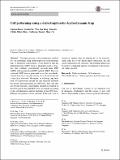| dc.contributor.author | Iliescu, Ciprian | |
| dc.contributor.author | Xu, Guolin | |
| dc.contributor.author | Tong, Wen Hao | |
| dc.contributor.author | Yu, Fang | |
| dc.contributor.author | Bălan, Cătălin Mihai | |
| dc.contributor.author | Tresset, Guillaume | |
| dc.contributor.author | Yu, Hanry | |
| dc.date.accessioned | 2016-10-21T20:42:18Z | |
| dc.date.available | 2016-10-21T20:42:18Z | |
| dc.date.issued | 2015-02 | |
| dc.date.submitted | 2014-05 | |
| dc.identifier.issn | 1613-4982 | |
| dc.identifier.issn | 1613-4990 | |
| dc.identifier.uri | http://hdl.handle.net/1721.1/104924 | |
| dc.description.abstract | The paper presents a dielectrophoretic method for cell patterning using dielectrophoretic–hydrodynamic trap. A distinctive characteristic of the device is that the dielectrophoretic (DEP) force is generated using a structure that combines conventional electrode-based DEP (eDEP) with insulator-based DEP method (iDEP). The conventional eDEP force is generated across the microfluidic channel between a top plate indium tin oxide electrode and a thin CrAu electrode. Meantime, an isolating cage built from SU8 photoresist around the thin electrode modifies the electric field generating an iDEP force. The cells that are flowing through a microfluidic channel are trapped in the SU8 cage by the total DEP force. As a result, according to the cell dimension and the thickness of the SU8 layer, different cell patterns can be achieved. If the cell’s size is sensitively smaller than the dimensions of the hydrodynamic trap, due to the dipole–dipole interaction, the cell can be organized in 3D structures. The trapping method can be used for conducting genetic, biochemical or physiological studies on cells. | en_US |
| dc.publisher | Springer Berlin Heidelberg | en_US |
| dc.relation.isversionof | http://dx.doi.org/10.1007/s10404-015-1568-2 | en_US |
| dc.rights | Article is made available in accordance with the publisher's policy and may be subject to US copyright law. Please refer to the publisher's site for terms of use. | en_US |
| dc.source | Springer Berlin Heidelberg | en_US |
| dc.title | Cell patterning using a dielectrophoretic–hydrodynamic trap | en_US |
| dc.type | Article | en_US |
| dc.identifier.citation | Iliescu, Ciprian et al. “Cell Patterning Using a Dielectrophoretic–hydrodynamic Trap.” Microfluidics and Nanofluidics 19.2 (2015): 363–373. | en_US |
| dc.contributor.department | Massachusetts Institute of Technology. Department of Biological Engineering | en_US |
| dc.contributor.mitauthor | Yu, Hanry | |
| dc.relation.journal | Microfluidics and Nanofluidics | en_US |
| dc.eprint.version | Author's final manuscript | en_US |
| dc.type.uri | http://purl.org/eprint/type/JournalArticle | en_US |
| eprint.status | http://purl.org/eprint/status/PeerReviewed | en_US |
| dc.date.updated | 2016-08-18T15:36:39Z | |
| dc.language.rfc3066 | en | |
| dc.rights.holder | Springer-Verlag Berlin Heidelberg | |
| dspace.orderedauthors | Iliescu, Ciprian; Xu, Guolin; Tong, Wen Hao; Yu, Fang; Bălan, Cătălin Mihai; Tresset, Guillaume; Yu, Hanry | en_US |
| dspace.embargo.terms | N | en |
| dc.identifier.orcid | https://orcid.org/0000-0002-0339-3685 | |
| mit.license | PUBLISHER_POLICY | en_US |
